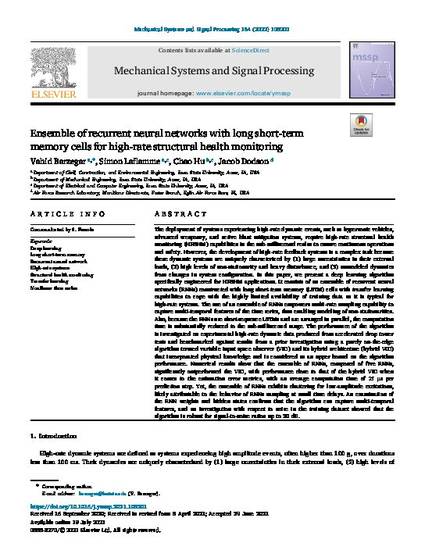
The deployment of systems experiencing high-rate dynamic events, such as hypersonic vehicles, advanced weaponry, and active blast mitigation systems, require high-rate structural health monitoring (HRSHM) capabilities in the sub-millisecond realm to ensure continuous operations and safety. However, the development of high-rate feedback systems is a complex task because these dynamic systems are uniquely characterized by (1) large uncertainties in their external loads, (2) high levels of non-stationarity and heavy disturbance, and (3) unmodeled dynamics from changes in system configuration. In this paper, we present a deep learning algorithm specifically engineered for HRSHM applications. It consists of an ensemble of recurrent neural networks (RNNs) constructed with long short-term memory (LSTM) cells with transfer learning capabilities to cope with the highly limited availability of training data as it is typical for high-rate systems. The use of an ensemble of RNNs empowers multi-rate sampling capability to capture multi-temporal features of the time series, thus enabling modeling of non-stationarities. Also, because the RNNs use short-sequence LSTMs and are arranged in parallel, the computation time is substantially reduced to the sub-millisecond range. The performance of the algorithm is investigated on experimental high-rate dynamic data produced from accelerated drop tower tests and benchmarked against results from a prior investigation using a purely on-the-edge algorithm termed variable input space observer (VIO) and its hybrid architecture (hybrid VIO) that incorporated physical knowledge and is considered as an upper bound on the algorithm performance. Numerical results show that the ensemble of RNNs, composed of five RNNs, significantly outperformed the VIO, with performance close to that of the hybrid VIO when it comes to the estimation error metrics, with an average computation time of 25 μs per prediction step. Yet, the ensemble of RNNs exhibits chattering for low-amplitude excitations, likely attributable to the behavior of RNNs sampling at small time delays. An examination of the RNN weights and hidden states confirms that the algorithm can capture multi-temporal features, and an investigation with respect to noise in the training dataset showed that the algorithm is robust for signal-to-noise ratios up to 20 dB.
Available at: http://works.bepress.com/simon_laflamme/141/

This article is published as Barzegar, Vahid, Simon Laflamme, Chao Hu, and Jacob Dodson. "Ensemble of recurrent neural networks with long short-term memory cells for high-rate structural health monitoring." Mechanical Systems and Signal Processing 164 (2022): 108201. DOI: 10.1016/j.ymssp.2021.108201.